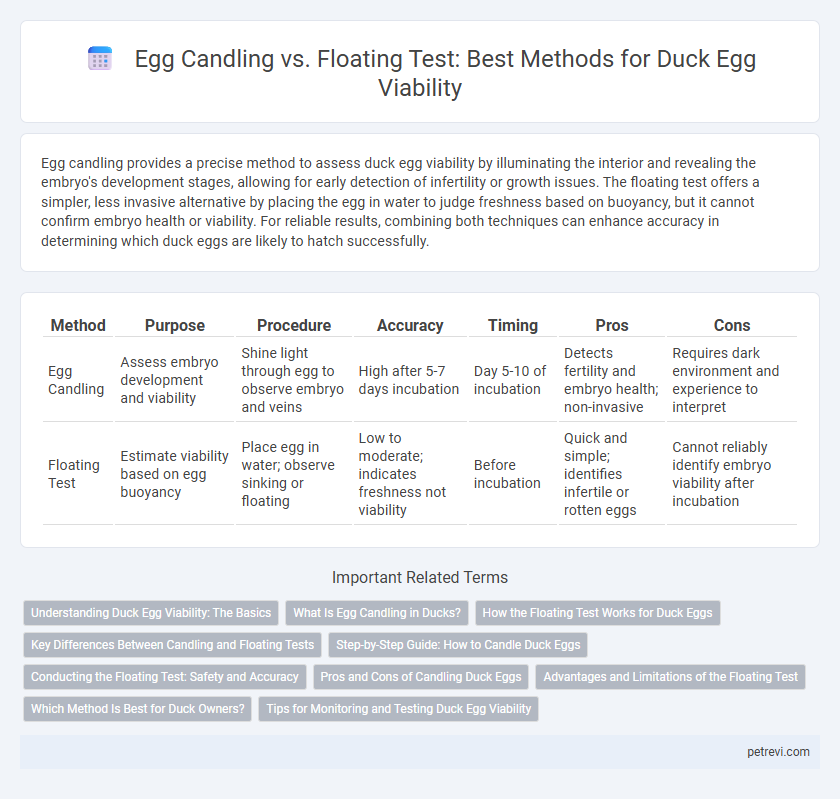Egg candling provides a precise method to assess duck egg viability by illuminating the interior and revealing the embryo's development stages, allowing for early detection of infertility or growth issues. The floating test offers a simpler, less invasive alternative by placing the egg in water to judge freshness based on buoyancy, but it cannot confirm embryo health or viability. For reliable results, combining both techniques can enhance accuracy in determining which duck eggs are likely to hatch successfully.
Table of Comparison
| Method | Purpose | Procedure | Accuracy | Timing | Pros | Cons |
|---|---|---|---|---|---|---|
| Egg Candling | Assess embryo development and viability | Shine light through egg to observe embryo and veins | High after 5-7 days incubation | Day 5-10 of incubation | Detects fertility and embryo health; non-invasive | Requires dark environment and experience to interpret |
| Floating Test | Estimate viability based on egg buoyancy | Place egg in water; observe sinking or floating | Low to moderate; indicates freshness not viability | Before incubation | Quick and simple; identifies infertile or rotten eggs | Cannot reliably identify embryo viability after incubation |
Understanding Duck Egg Viability: The Basics
Egg candling and the floating test are essential methods for assessing duck egg viability during incubation. Candling involves shining a light through the egg to observe embryo development and detect any abnormalities, providing a non-invasive way to monitor growth stages. The floating test helps determine egg freshness by submerging the egg in water; viable eggs typically sink or stand upright, while non-viable eggs float due to internal gas buildup.
What Is Egg Candling in Ducks?
Egg candling in ducks involves shining a bright light through the eggshell to observe the embryo's development and identify viability. This method allows farmers and breeders to detect fertilization, monitor growth stages, and spot any abnormalities during incubation. Compared to the floating test, egg candling provides a more precise and non-invasive way to assess duck egg fertility and embryo health.
How the Floating Test Works for Duck Eggs
The floating test for duck egg viability relies on assessing buoyancy, where eggs are placed in water to observe their position. Viable duck eggs typically sink and lie flat on the bottom due to lower internal air cell development, while infertile or non-viable eggs float or stand upright, indicating increased air pockets from decomposition or age. This simple method helps quickly gauge egg freshness and potential hatchability without specialized equipment.
Key Differences Between Candling and Floating Tests
Egg candling uses a bright light source to illuminate the interior of a duck egg, revealing embryo development and blood vessel patterns essential for assessing viability. The floating test determines egg freshness and viability by observing buoyancy; viable duck eggs typically sink or stand upright due to lower air cell size. Candling provides detailed embryonic insights, while floating is a simpler, less precise method primarily suited for freshness evaluation.
Step-by-Step Guide: How to Candle Duck Eggs
To candle duck eggs, hold the egg gently in a dark room using a bright LED flashlight or specialized egg candler, shining light through the broader end to observe the interior. Look for distinct veins and the embryo's outline indicating viability, while clear or uniformly dark eggs suggest infertility or non-viability. Perform candling between days 7 to 14 of incubation for accurate assessment, avoiding excessive heat or light exposure to not harm the developing duck embryo.
Conducting the Floating Test: Safety and Accuracy
Conducting the floating test for duck egg viability involves carefully placing the egg in a container of water to observe its buoyancy, which indicates the development stage of the embryo inside. Ensure the water temperature matches the duck egg's natural incubation environment to avoid harming the embryo and to maintain test accuracy. This method provides a simple, non-invasive way to assess viability but is less precise than candling, which uses light to reveal detailed embryo growth.
Pros and Cons of Candling Duck Eggs
Egg candling offers a non-invasive method to monitor duck egg viability by allowing visual inspection of embryo growth and development stages. It helps detect infertile or non-developing eggs early, reducing resource waste; however, it requires a dark environment and skill to interpret the images accurately. Although it poses minimal risk to the egg, improper candling techniques can potentially harm the delicate embryo or disrupt incubation conditions.
Advantages and Limitations of the Floating Test
The floating test for duck egg viability offers a simple, non-invasive method to estimate embryo development by observing egg buoyancy changes caused by air cell size. Its advantages include quick assessment without specialized equipment and suitability for large-scale screening in hatcheries. Limitations arise from its lower accuracy compared to egg candling, as it cannot distinguish between infertile, early dead embryos, or very fresh eggs, potentially leading to misinterpretation of viability.
Which Method Is Best for Duck Owners?
Egg candling offers precise insights into embryonic development by illuminating the duck egg's interior, enabling owners to detect fertility and growth stages accurately. The floating test provides a quick, non-invasive estimation of viability based on buoyancy, where sinking eggs are typically fertile and floating eggs suggest non-viability or age. For duck owners prioritizing accuracy and early detection of viable embryos, egg candling is the superior method compared to the less reliable floating test.
Tips for Monitoring and Testing Duck Egg Viability
Egg candling offers precise insight into duck egg embryo development by illuminating the interior to detect growth stages, veins, and fertility, making it an essential method for early viability assessment. The floating test provides a quick and simple way to estimate egg freshness by observing buoyancy, since viable eggs usually sink due to dense contents, while non-viable or older eggs tend to float. Combining candling with regular monitoring intervals and maintaining stable incubation conditions improves the accuracy of identifying viable duck eggs and increases hatching success rates.
Egg candling vs Floating test for Duck egg viability Infographic

 petrevi.com
petrevi.com